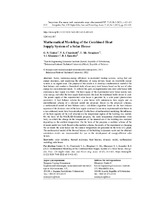| dc.contributor.author | Uzakov, G. N. | |
| dc.contributor.author | Charvinski, V. L. | |
| dc.contributor.author | Ibragimov, U. Kh. | |
| dc.contributor.author | Khamraev, S. I. | |
| dc.contributor.author | Kamolov, B. I. | |
| dc.coverage.spatial | Минск | ru |
| dc.date.accessioned | 2022-11-11T11:54:39Z | |
| dc.date.available | 2022-11-11T11:54:39Z | |
| dc.date.issued | 2022 | |
| dc.identifier.citation | Mathematical Modeling of the Combined Heat Supply System of a Solar House = Математическое моделирование комбинированной системы теплоснабжения солнечного дома / G. N. Uzakov [et al.] // Известия высших учебных заведений и энергетических объединений СНГ. Энергетика. – 2022. – № 5. – С. 412-421. | ru |
| dc.identifier.uri | https://rep.bntu.by/handle/data/122365 | |
| dc.description.abstract | Today, increasing energy efficiency in residential heating systems, saving fuel and energy resources, and improving the efficiency of using devices based on renewable energy sources is an urgent issue. The purpose of the article is to develop a mathematical model of the heat balance and conduct a theoretical study of one-story rural houses based on the use of solar energy in a non-stationary mode. To achieve this goal, an experimental one-story solar house with autonomous heat supply was built. The heat supply of the experimental solar house mainly uses solar energy, and when the heat supply load exceeds this load, the traditional boiler device is used. The power supply of the experimental solar house is provided by a solar panel (photovoltaic converter). A heat balance scheme for a solar house with autonomous heat supply and an electrothermal scheme of a physical model are proposed. Based on the proposed schemes, a mathematical model of heat balance and a calculation algorithm based on the heat balance equation of the dynamic state of the heat supply system of a one-story experimental solar house in a non-stationary mode have been developed. On the basis of mathematical modeling, the influence of the heat capacity of the wall structure on the temperature regime of the building was studied. On the basis of the MATLAB-Simulink program, the main temperature characteristics were built, on which the change in the temperature of the internal air of the building was analyzed depending on the ambient temperature. On the basis of the program, a modular scheme of the dynamic model was built. Based on the modular scheme, the results of the experiment on changing the air inside the solar house and the outdoor temperature are presented in the form of a graph. The mathematical model of the thermal balance of the building in dynamic mode and the obtained calculation results are recommended for use in the development of energy-efficient solar houses. | ru |
| dc.language.iso | en | ru |
| dc.publisher | БНТУ | ru |
| dc.title | Mathematical Modeling of the Combined Heat Supply System of a Solar House | ru |
| dc.title.alternative | Математическое моделирование комбинированной системы теплоснабжения солнечного дома | ru |
| dc.type | Article | ru |
| dc.identifier.doi | 10.21122/1029-7448-2022-65-5-412-421 | |
| local.description.annotation | Вопросы экономии топливно-энергетических ресурсов, повышения эффективности систем теплоснабжения жилых помещений, а также использования устройств на основе возобновляемых источников энергии на сегодняшний день имеют особую актуальность. Цель статьи – разработать математическую модель теплового баланса и провести теоретическое исследование одноэтажных сельских домов, использующих солнечную энергию в нестационарном режиме. Для ее реализации построен экспериментальный одноэтажный солнечный дом с автономным теплоснабжением на основе преимущественно солнечной энергии. В случаях, если нагрузка на теплоснабжение превышает солнечную нагрузку, применяется традиционное котельное устройство. Электроснабжение экспериментального дома обеспечивается солнечной панелью (фотоэлектрическим преобразователем). Предложены схема теплового баланса солнечного дома с автономным теплоснабжением и электротепловая схема физической модели. На их основе разработаны математическая модель и алгоритм расчета, базирующийся на уравнении теплового баланса динамического состояния системы теплоснабжения экспериментального дома в нестационарном режиме. Исследовано влияние теплоемкости стеновой конструкции на температурный режим здания. В среде моделирования MATLAB-Simulink построены основные температурные характеристики, на которых проанализировано изменение температуры внутреннего воздуха здания в зависимости от температуры окружающей среды. Построена модульная схема динамической модели, результаты эксперимента по изменению воздуха внутри солнечного дома и температуры наружного воздуха представлены в виде графика. Математическая модель теплового баланса здания в динамическом режиме и результаты расчетов могут использоваться при разработке энергоэффективных солнечных домов. | ru |

